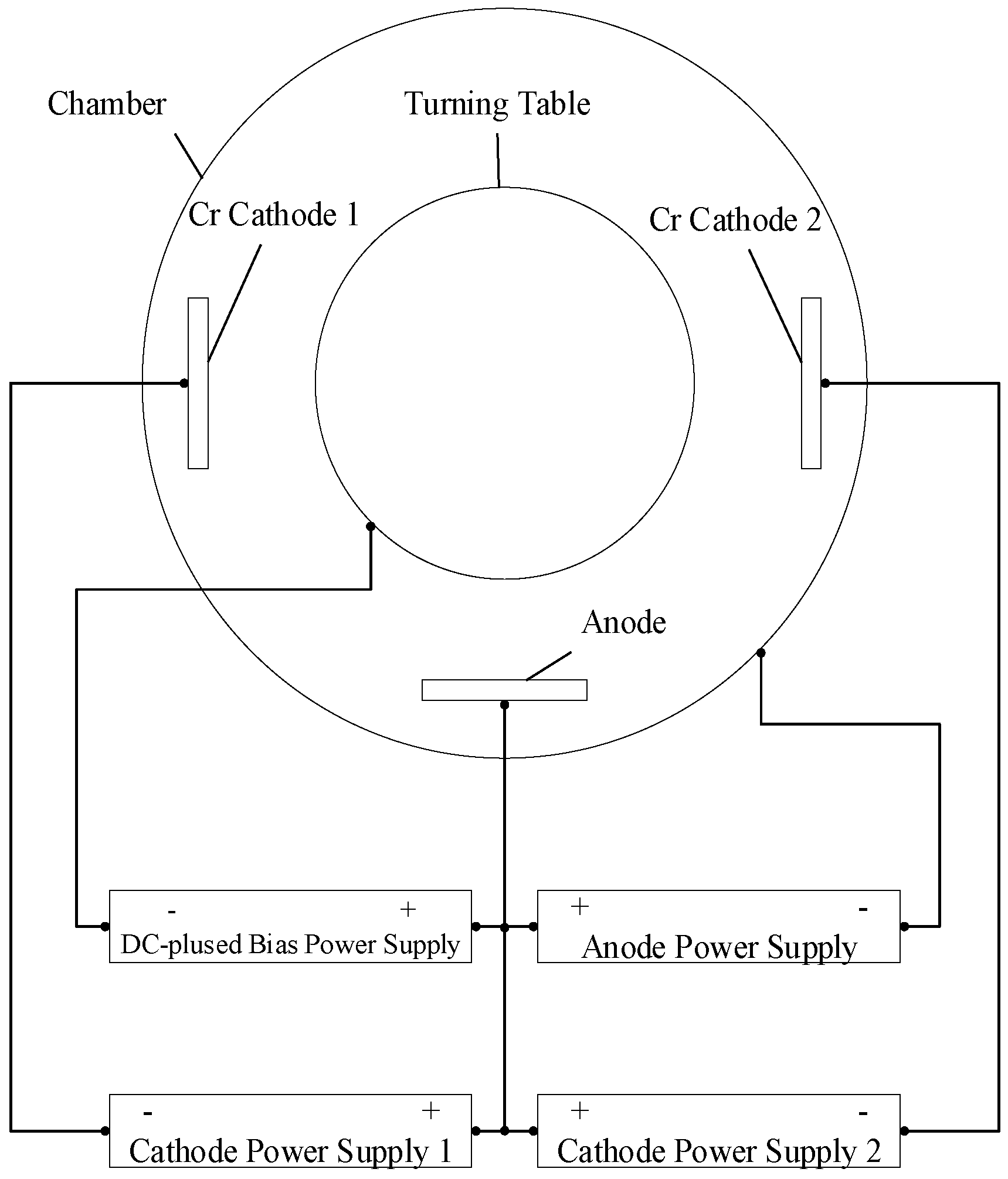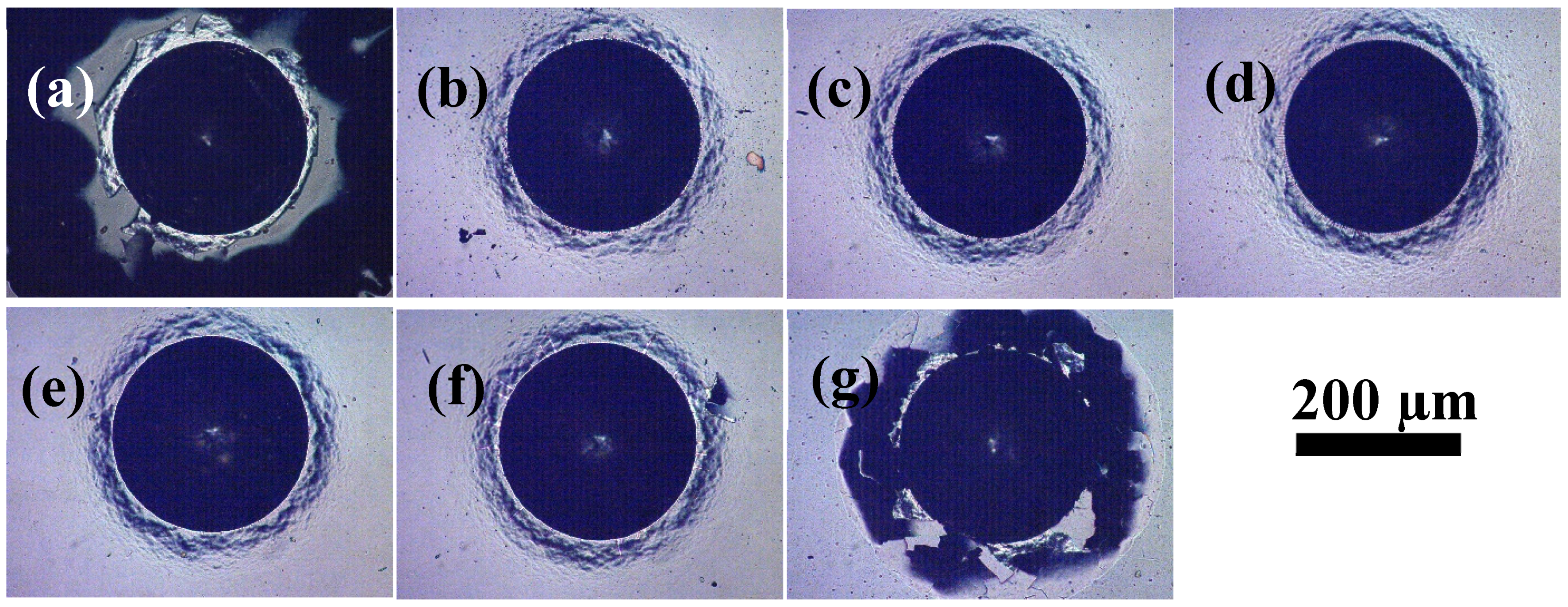Adhesion Studies of CrC/a-C:H Coatings Deposited with Anode Assisted Reactive Magnetron Sputtering Combined with DC-Pulsed Plasma Enhanced Chemical Vapor Deposition
Abstract
:1. Introduction
2. Materials and Methods
2.1. Film Preparation
2.2. Film Characterization
3. Results and Discussion
4. Conclusions
Author Contributions
Funding
Institutional Review Board Statement
Informed Consent Statement
Data Availability Statement
Conflicts of Interest
References
- Robertson, J. Diamond-Like Amorphous Carbon. Mater. Sci. Eng. R Rep. 2002, 37, 129–281. [Google Scholar] [CrossRef] [Green Version]
- Bewilogua, K.; Hofmann, D. History of Diamond-Like Carbon Films—From First Experiments to Worldwide Applications. Surf. Coat. Technol. 2014, 242, 214–225. [Google Scholar] [CrossRef]
- Héau, C. DLC Films in Mechanical, Manufacturing Industry. In Tribology of Diamond-Like Carbon Films—Fundamentals and Applications; Donnet, C., Erdemir, A., Eds.; Springer: New York, NY, USA, 2008; pp. 469–483. [Google Scholar]
- Treutler, C.P.O. Industrial Use of Plasma-Deposited Coatings for Components of Automotive Fuel Injection Systems. Surf. Coat. Technol. 2005, 200, 1969–1975. [Google Scholar] [CrossRef]
- Kano, M. Dlc Coating Technology Applied to Sliding Parts of Automotive Engine. New Diam. Front. Carbon Technol. 2006, 16, 201–210. [Google Scholar]
- Tillmann, W.; Lopes Dias, N.F.; Stangier, D. Tribo-Mechanical Properties of Crc/a-C Thin Films Sequentially Deposited by Hipims and Mfms. Surf. Coat. Technol. 2018, 335, 173–180. [Google Scholar] [CrossRef]
- Voevodin, A.A.; Capano, M.A.; Laube, S.J.P.; Donley, M.S.; Zabinski, J.S. Design of a Ti/Tic/Dlc Functionally Gradient Coating Based on Studies of Structural Transitions in Ti–C Thin Films. Thin Solid Films 1997, 298, 107–115. [Google Scholar] [CrossRef]
- Stüber, M.; Ulrich, S.; Leiste, H.; Kratzsch, A.; Holleck, H. Graded Layer Design for Stress-Reduced and Strongly Adherent Superhard Amorphous Carbon Films. Surf. Coat. Technol. 1999, 116–119, 591–598. [Google Scholar] [CrossRef]
- Lee, K.-R.; Yong Eun, K.; Kim, I.; Kim, J. Design of W Buffer Layer for Adhesion Improvement of Dlc Films on Tool Steels. Thin Solid Films 2000, 377–378, 261–268. [Google Scholar] [CrossRef]
- Vetter, J. 60 years of Dlc Coatings: Historical Highlights and Technical Review of Cathodic Arc Processes to Synthesize Various Dlc Types, and Their Evolution for Industrial Applications. Surf. Coat. Technol. 2014, 257, 213–240. [Google Scholar] [CrossRef]
- Bugaev, S.P.; Podkovyrov, V.G.; Oskomov, K.V.; Smaykina, S.V.; Sochugov, N.S. Ion-Assisted Pulsed Magnetron Sputtering Deposition of Ta-C Films. Thin Solid Films 2001, 389, 16–26. [Google Scholar] [CrossRef]
- DeKoven, B.M.; Ward, P.R.; Weiss, R.E.; Christie, R.A.; Scholl, W.; Sproul, D.; Tomasel, F.; Anders, A. Carbon Thin Film Deposition Using High Power Pulsed Magnetronsputtering. In Proceedings of the 2003 Annual Technical Meeting of the Society of Vacuum Coaters, San Francisco, CA, USA, 15 April 2003. [Google Scholar]
- Sarakinos, K.; Braun, A.; Zilkens, C.; Mráz, S.; Schneider, J.M.; Zoubos, H.; Patsalas, P. Exploring the Potential of High Power Impulse Magnetron Sputtering for Growth of Diamond-Like Carbon Films. Surf. Coat. Technol. 2012, 206, 2706–2710. [Google Scholar] [CrossRef] [Green Version]
- Catherine, Y. Preparation Techniques for Diamond-Like Carbon. In Diamond and Diamond-Like Films and Coatings; Clausing, R.E., Horton, L.L., Angus, J.C., Koidl, P., Eds.; Springer: Boston, MA, USA, 1991; pp. 193–227. [Google Scholar] [CrossRef]
- An, X.; Wu, Z.; Liu, L.; Shao, T.; Xiao, S.; Cui, S.; Lin, H.; Fu, R.K.Y.; Tian, X.; Chu, P.K.; et al. High-Ion-Energy and Low-Temperature Deposition of Diamond-Like Carbon (Dlc) Coatings with Pulsed Kv Bias. Surf. Coat. Technol. 2019, 365, 152–157. [Google Scholar] [CrossRef]
- Yossef, D.; Tali, I.; Yehonatan, R.; Dror, M.; Danping, L.; Zeev, Z. Silicon-Coated Gold Nanoparticles Nanoscopy. J. Nanophotonics 2016, 10, 1–9. [Google Scholar]
- Malka, D.; Danan, Y.; Ramon, Y.; Zalevsky, Z. A Photonic 1 × 4 Power Splitter Based on Multimode Interference in Silicon–Gallium-Nitride Slot Waveguide Structures. Materials 2016, 9, 516. [Google Scholar] [CrossRef] [Green Version]
- Liao, B.-H.; Hsiao, C.-N.; Lee, C.-C. Aluminum Oxyfluoride Films for Deep Ultraviolet Optics Deposited by a Combined Hipims/Cfubms Deposition Technique. Opt. Mater. Express 2016, 6, 1506–1512. [Google Scholar] [CrossRef]
- Baran, Ö.; Bidev, F.; Çiçek, H.; Kara, L.; Efeoğlu, İ.; Küçükömeroğlu, T. Investigation of the Friction and Wear Properties of Ti/Tib2/Mos2 Graded-Composite Coatings Deposited by Cfubms under Air and Vacuum Conditions. Surf. Coat. Technol. 2014, 260, 310–315. [Google Scholar] [CrossRef]
- Arslan, E.; Totik, Y.; Efeoglu, I. The Investigation of the Tribocorrosion Properties of Dlc Coatings Deposited on Ti6al4v Alloys by Cfubms. Prog. Org. Coat. 2012, 74, 768–771. [Google Scholar] [CrossRef]
- Bülbül, F.; Efeoğlu, İ. The Effect of Tic Transient Layer on a Dlc-Based Functionally Gradient Coating Prepared by Closed Field Unbalanced Magnetron Sputtering Plating System. Metals Mater. Int. 2010, 16, 573–580. [Google Scholar] [CrossRef]
- Münz, W.-D.; Zufrass, T. Industrial Scale Deposition of Well Adherent Superhard and Low Friction C-Dlc Coatings Grown by Hipims and Anode Assisted Unbalanced Magnetron Sputtering. Surf. Coat. Technol. 2020, 387, 125485. [Google Scholar] [CrossRef]
- Zehnder, T.; Patscheider, J. Nanocomposite Tic/a–C:H Hard Coatings Deposited by Reactive Pvd. Surf. Coat. Technol. 2000, 133–134, 138–144. [Google Scholar] [CrossRef]
- Grill, A. Diamond-Like Carbon: State of the Art. Diam. Relat. Mater. 1999, 8, 428–434. [Google Scholar] [CrossRef]
- Gangopadhyay, A.; Sinha, K.; Uy, D.; McWatt, D.G.; Zdrodowski, R.J.; Simko, S.J. Friction, Wear, and Surface Film Formation Characteristics of Diamond-Like Carbon Thin Coating in Valvetrain Application. Tribol. Trans. 2010, 54, 104–114. [Google Scholar] [CrossRef]
- Cemin, F.; Boeira, C.D.; Figueroa, C.A. On the Understanding of the Silicon-Containing Adhesion Interlayer in Dlc Deposited on Steel. Tribol. Int. 2016, 94, 464–469. [Google Scholar] [CrossRef]
- Andersson, M.; Högström, J.; Urbonaite, S.; Furlan, A.; Nyholm, L.; Jansson, U. Deposition and Characterization of Magnetron Sputtered Amorphous Cr–C Films. Vacuum 2012, 86, 1408–1416. [Google Scholar] [CrossRef]
- Martínez-Martínez, D.; López-Cartes, C.; Fernández, A.; Sánchez-López, J.C. Influence of the Microstructure on the Mechanical and Tribological Behavior of Tic/a-C Nanocomposite Coatings. Thin Solid Films 2009, 517, 1662–1671. [Google Scholar] [CrossRef]
- Takeno, T.; Komiyama, T.; Miki, H.; Takagi, T.; Aoyama, T. Xps and Tem Study of W-Dlc/Dlc Double-Layered Film. Thin Solid Films 2009, 517, 5010–5013. [Google Scholar] [CrossRef]
- Gassner, G.; Patscheider, J.; Mayrhofer, P.; Hegedus, E.; Toth, L.; Kovacs, I.; Pécz, B.; Srot, V.; Scheu, C.; Mitterer, C. Structure of Sputtered Nanocomposite CrCx/a-C: H Thin Films. J. Vac. Sci. Technol. 2006, 24, 1837–1843. [Google Scholar] [CrossRef] [Green Version]










| Process Parameters | Unit | CrC | a-C:H |
|---|---|---|---|
| Pressure | [Pa] | 0.3 | 1.2 |
| Ar flow | [sccm] | Pressure control | - |
| C2H2 flow | [sccm] | 0–30 | Pressure control |
| Cathode power | [W/cm2] | 10 | - |
| Bias Voltage | [V] | −100, 250 kHz, 1.2 µs | −600, 120 kHz, 1.2 µs |
| Time | [s] | 2400 | 7200 |
| Coating | Adhesion Class | Lc1 [N] | Lc2 [N] | Lc3 [N] |
|---|---|---|---|---|
| CrC0/a-C:H | HF6 | - | 1.1 | 5.6 |
| CrC5/a-C:H | HF2 | 27.9 | 20.3 | 56.0 |
| CrC10/a-C:H | HF2 | - | 13.7 | 68.1 |
| CrC15/a-C:H | HF1 | 43.4 | 41.0 | 74.0 |
| CrC20/a-C:H | HF1 | 48.7 | 58.3 | 73.9 |
| CrC25/a-C:H | HF3 | - | 21.6 | 34.1 |
| CrC30/a-C:H | HF6 | - | 15.2 | 22.4 |
Publisher’s Note: MDPI stays neutral with regard to jurisdictional claims in published maps and institutional affiliations. |
© 2021 by the authors. Licensee MDPI, Basel, Switzerland. This article is an open access article distributed under the terms and conditions of the Creative Commons Attribution (CC BY) license (https://creativecommons.org/licenses/by/4.0/).
Share and Cite
Huang, Z.; Chen, Z.; Lang, W.; Wang, X. Adhesion Studies of CrC/a-C:H Coatings Deposited with Anode Assisted Reactive Magnetron Sputtering Combined with DC-Pulsed Plasma Enhanced Chemical Vapor Deposition. Materials 2021, 14, 2954. https://doi.org/10.3390/ma14112954
Huang Z, Chen Z, Lang W, Wang X. Adhesion Studies of CrC/a-C:H Coatings Deposited with Anode Assisted Reactive Magnetron Sputtering Combined with DC-Pulsed Plasma Enhanced Chemical Vapor Deposition. Materials. 2021; 14(11):2954. https://doi.org/10.3390/ma14112954
Chicago/Turabian StyleHuang, Zhihong, Zhijie Chen, Wenchang Lang, and Xianghong Wang. 2021. "Adhesion Studies of CrC/a-C:H Coatings Deposited with Anode Assisted Reactive Magnetron Sputtering Combined with DC-Pulsed Plasma Enhanced Chemical Vapor Deposition" Materials 14, no. 11: 2954. https://doi.org/10.3390/ma14112954






